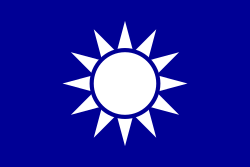Pan-blue coalition
The Pan-Blue Coalition ( Chinese 泛藍 聯盟 / 泛蓝 联盟 , Pinyin Fànlán Liánméng ), or Pan-Blue Forces ( Chinese 泛藍 軍 / 泛蓝 军 , Pinyin Fànlán Jūn ), is an informal party coalition in the Republic of China on Taiwan , consisting of the Kuomintang (KMT), the Qinmindang ('People's Party') (PFP) and the smaller Xindang ('New Party') (CNP). The name of the coalition comes from the blue flag of the KMT. In contrast to the pan-green coalition , it supports Chinese nationalism and a policy of rapprochement with the People's Republic of China .
In the long term, the pan-blue coalition is pursuing the reunification of China (under nationalist conditions), but is only pursuing this goal subliminally and instead officially adopting a more neutral stance to maintain the status quo . The main motivation for or against the coalition is mostly due to the coalition's strong relationship with mainland China . Be that as it may, the economy is also a major factor in this process.
Origin and history
During the 1990s, there was a rift within the KMT between those who wanted to promote a Taiwanese Chinese identity, in line with a reunification tendency, and those who wanted a stronger Taiwanese identity, led by then-President Lee Teng-hui . This break resulted in the formation of the Xindang ('New Party') . During the presidential election in 2000 , Lee Teng-hui ensured that Lien Chan ran for the KMT, replacing the more popular James Soong . He then broke away from the party and founded the Qinmindang (“People's Party”) , which takes a more “pro-Chinese” position than the KMT with regard to the identity of Taiwan. However, both candidates were beaten in the 2000 presidential election by DPP candidate Chen Shui-bian .
During the presidential election, the rift between pan-blue voters, who had to choose between two candidates from their own ranks, led to Chen winning. Lee Teng-hui, who was blamed for the election defeat, was expelled from the party and founded his own party, the pan-green Taiwan Solidarity Union (TSU). After Lee's expulsion, the KMT became more conservative again and began an informal but close cooperation with the Qinmindang and the Xindang. This collaboration was the hour of birth of the pan-blue coalition. Nevertheless, the coalition retains its separate party structures, with electoral strategies being decided and implemented together. In the 2004 presidential election , for example, Lien Chan (KMT) ran for president and James Soong (Qinmindang) as vice president. The campaign emblem was a tandem with a blue (KMT) and an orange (Qinmindang) figure.
There were even talks about a merger between KMT and Qinmindang for 2005, but these were put on hold. In the 2004 legislative elections , the three pan-blue parties organized themselves to such an extent that they shared votes instead of competing for one another ( Chinese 配 票 , Pinyin Pèipiào ). Xindang presented all but one of the candidates under the KMT logo. As a result, the KMT won 11 seats and the DPP lost 12. After the election, Qinmindang chairman James Soong accused the KMT of having abused his party for its own interests and announced that it would no longer conduct inter-party negotiations. Soong's announcement was strongly condemned by the KMT, the majority of the Qinmindang, and the Xindang.
On February 24, 2005, James Soong met President Chen Shui-bian for the first time in four years and issued a "10-point declaration" that included the name "Republic of China", the status quo in the strait and the three connections (Post , Transport and trade) treated and endorsed. Lien, on the other hand, did not respond to Chen's invitation to a meeting. After the big "pan-blue visit to China " in 2005, Soong and Chen cut ties.
The legislative yuan election on January 12, 2008 brought the opposition Pan-Blue coalition a landslide victory over the ruling Pan-Green coalition. The election for the legislative yuan on January 14, 2012 was also won by the parties of the Pan-Blue coalition. The subsequent election for the legislative yuan in 2016 and the presidential election in 2016 were lost.
literature
- Thomas Weyrauch: Taiwan's common color. The Democratic Profile of the Republic of China . Heuchelheim: Longtai 2015, ISBN 978-3-938946-26-8 .
See also
- pan-green coalition
- pan-violet coalition , a socially active umbrella organization
- Taiwan conflict
- Black gold (politics)
Web links
- Official website of the Kuomintang中國 國民黨
- Chinese Pan-blue website中國 泛藍 聯盟
- Official website of the People's Party親民 黨
- Editorial: Taiwan's color spectrum widens - The Taipei Times editorial on the colored coalitions
- Exploring Chinese History

